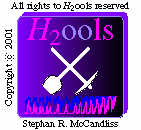-
Accepted by PASP 03-05-2003. H2ools reference.
-
H2tautemplates
(Updated 06 November 2017 to include ascii and fits format templates.) Is an html link to a set of gzip tar files containing templates of molecular hydrogen optical depths calculated on 0.01 Angstrom grid for a column density of Log(N(cm^-2))=21. The ReadMe file in that directory contains a short idl program to read these data within idl and explains what the file name means. The idl program will need a little editing to point to the directory where you store the optical depth files. To down load press the shift key and left click. Save as text. An example of the spectra models can be examined here. To make a spectrum for absorption out of the Jth rotational level from the optical depth you divide by 1e21 and multiply by the desired column density and then take the exponent (base e) (the negative sign has been supplied). The optical depths for various column densities and rotational levels should be added together before taking the exponent.
(03-09-2003) Templates with v''<=3 are now available.
(02-06-2003) The directory structure below H2tautemplates has been reorganized to accommodate templates with
v''>0.
(02-06-2003) The b=1km/sec templates are undersampled with the current wavelength grid spacing of 0.01 Angstroms. The b=1km/sec templates should not be used for quantitative work. Here are how the equivalent widths, numerically integrated from the templates for a range of Nflambda, compare to theory for various doppler parameters. See the reference for details.
(04-30-2002) Byteswapped templates
now available for those of you with linux machines courtesy of Pat Romano
at Ohio State.
-
h1h2data as html link for atomic and molecular hydrogen data. I originally got the atomic data from people working on the HUT project. The molecular data comes from Abgrall et al. (Lyman) and Abgrall et al. (Werner) , by way of Brian Wolven (who compiled the original database and included the damping
parameters) and myself (who created its present format).
(07-05-2002) Excited vibrational state databases for v'' = 1 -- 7 are can now be found in highjsh2vpnvpp1.dat -- highjsh2vpnvpp7.dat.
-
atoms2oo Morton subset as html link contains a limited amount of atomic data for ground state lines culled from the lists of Morton (Atomic Data for Resonance Absorption Lines). These files are in ascii and the data can be read into idl with the programs provided in the idl directory, ( which have names like ariread.pro)
-
kurucz.list and kurucz.ascii are the parameter list of the Kurucz stellar models and the actual models in ascii format that I ripped out of Cloudy.
They are accessed through the (very inefficient) idl program atlas.pro
found in the idl directory (see below).
-
idl contains some
code for making bigplots of FUSE data and example of which is shown
here (M27
= the Dumbbell = NGC6853).
idl program listing
CAMMforPeter.pro-- is a main
program. It calls most of the other programs in this directory.
It won't work until you get all the data and procedure file names correctly
named. Imbedded within this program are calls to make a synthetic
spectrum. The program starts with a selected atlas model, which
is then attenuated with extinction by dust, and absorption by atomic and
molecular hydrogen. Orbital concatenations of individual FUSE
spectral segments are then joined after interpolating onto a common wavelength
grid.
A bigplot is then produced with the synthetic spectrum overlaid.
Atomic and molecular
line positions are also overlaid. The bigplot is
a postscript file and is best viewed with gv on unix machines. On
other operating systems you will have to experiment.
ariread.pro -- and its friends feiiread.pro,
niiread.pro, etc... read in the Morton atomic data stored under the
directory atoms2oo
. CAMMfor Peter.pro uses this information to overplot line identifications.
The data can also be used to compute an absorption line
spectrum for the given atomic species, but you will have to write it
yourself.
atlas.pro -- reads in the Kurucz
stellar models.
convolute.pro -- is used by newjoin.pro
to find the segment shifts before joining the spectral segments.
fm.pro -- is a simple Fitzpatrick
and Massa extinction routine.
h1abs.pro -- computes an atomic
hydrogen absorption spectrum and can handle
multiple velocity components.
h2data.pro -- reads in the molecular
hydrogen data stored under h1h2data
h2label.pro -- does what h2data.pro
does and then overplots a label with a tick marker proportional to
the line core optical depth on a previously displayed plot.
It is very useful for making molecular hydrogen line identifications.
hline.pro -- and its companion vline.pro
is a program witten by Eric Burgh to overplot a horizontial (vertical) line on a previously displayed plot.
make_kernel.pro -- was written by Brian Wolven . It makes up a kernel for convolving
the synthetic spectrum to a desired FWHM.
new_join.pro -- Computes a weighted shifted average of all the spectral segments. Works pretty well but use caution.
rescol.pro -- produces a ten element
color table with the color indices of :
0=white, 1=brown, 2=red, 3=orange, 4=yellow, 5=green, 6=blue, 7=violet,
8=grey, 9=black
